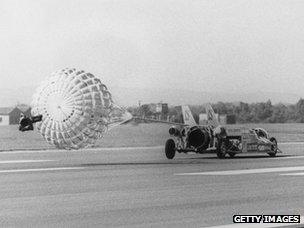Orange, Intel, and a fast car furore
- Published
- comments

Richard Noble
It is a story involving a major mobile phone company, a global technology brand, and an exciting British project to build the world's fastest car and inspire a new generation of young engineers. Intel, Orange and Richard Noble's Bloodhound SSC car sound like natural bedfellows - but Mr Noble claims the two companies have used his intellectual property without permission, and put the project's future in doubt.
In the 1990s the Thrust SSC broke the sound barrier - now the Bloodhound supersonic car, external aims to go faster than 1,000 MPH. The project has attracted a loyal community of fans and supporters, including thousands of schoolchildren.
Last week a television advert for Orange's new San Diego mobile phone, powered by an Intel processor, was broadcast for the first time, external. It featured a supersonic car which looked very similar to the Thrust SSC - so much so that many fans assumed that it was part of a sponsorship deal, done with Mr Noble's agreement and earning a healthy fee for the project.
Not so. "We were absolutely gobsmacked when we saw the ad," Richard Noble told me last night. He said they'd had hundreds of messages. "From all over the world people congratulated me, people assumed we were getting paid for it."
But why was he so sure that the car in the advert was modelled on his? "There is only one car in the world like that. It's absolutely unique. The whole ad is about supersonic performance and ours is the only supersonic car."
The irony is that Intel is a sponsor of the Bloodhound project, though Mr Noble says the firm had not been involved in the Thrust. Orange, on the other hand, had talked back in the 1990s about sponsoring the Thrust, but that had come to nothing. Neither had ever discussed using either car in an advert - or paying to do so.

Thrust 2 driven by Richard Noble, breaking the British land speed record in 1980
The Bloodhound team has lodged a complaint with the Advertising Standards Authority, but that has already been rejected because intellectual property disputes are not part of the regulator's remit. Now Mr Noble is talking to his lawyers about his next move.
"Our only asset is the iconography," he said when I asked him why any of this mattered. He explained that the project only survived on donations from the public, coupled with money from sponsors. "If this is allowed to proceed then these big companies will think they don't need to go to the expense of sponsoring. They can just take what they want."
I put Richard Noble's accusations to Intel and Orange. They produced a joint statement explaining that the advert featured a superfast car to illustrate just how fast the device is:
"Our production team researched many different styles of superfast vehicles in the run up to making the ad, but we chose to develop and film our own Orange branded land speed car. Since it has aired, we've become aware of comments made by the Bloodhound Project team, and would like to make it clear that the advert and handset are not associated with, endorsed by or otherwise connected to Sir Richard Noble or the Bloodhound SSC team. However we would like to wish them all the best in their land speed quest."
I'm not sure that Richard Noble - who hasn't been knighted as far as I know - will accept those good wishes. He has a missionary zeal about the potential of his project, pointing out that more than 5,000 schools have joined the Bloodhound education programme, external, which aims to give children a sense that engineering can be an exciting and rewarding career. "This country needs engineers," he told me," and Bloodhound will deliver that."
It all might seem a relatively trivial affair, but Intel and Orange should be aware that Mr Noble has friends in high places. It was a call from a government advisor which alerted me to this story. He seemed rather cross that a project which brought together so much British engineering expertise was being treated in this way by two powerful technology firms.